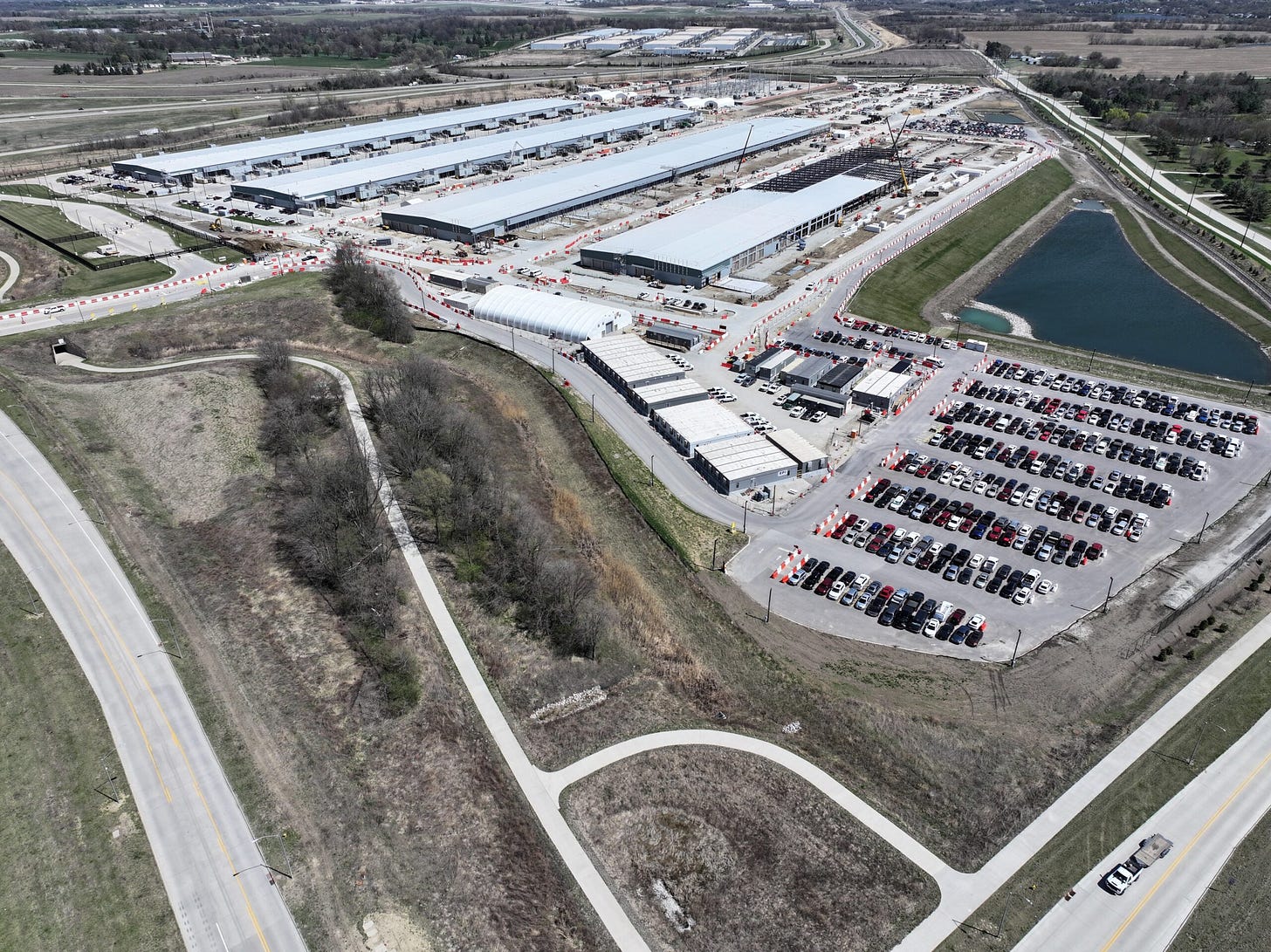Why Journalism Matters
Investigating AI's impact on water consumption. Syrian journalists' remarkable efforts to document the country's notorious prisons and saluting young investigative journalists.
5 minute read
AI,AI everywhere…but not a drop to drink

We are currently living through the turmoil caused by climate change and resource depletion which has led us to the drive towards net zero by way of energy use efficiency and development of fossil-fuel free technologies.
In this period of re-orientation the world is being encouraged to embrace Artificial Intelligence (AI) and other data-intensive data technologies that have the power to transform our lives.
This optimism is forthcoming despite the negative impact AI is predicted to have on jobs as working people are replaced by robots and Chat Bots, available 24/7 at the click of a mouse. The corporate powers of persuasion continue busying themselves in ‘guiding’ our choices and preferences towards the use of more technology and machines to solve the problems largely brought about by their introduction in the first place, and their current excessive use.
But what is not widely discussed prominently in the mainstream media is the environmental impact that AI technology is having, particularly on energy use and the massive water consumption needed to cool large data centres being built around the world.
What better way to introduce this subject than to do a Google AI Overview search into the growth of data centres and their environmental impact. Here’s what came up.
· Factors Driving Growth:
The growth in data centre energy consumption is fueled by the increasing demand for cloud computing, AI, machine learning, cryptocurrency mining, and other data-intensive applications.
· Challenges:
The increasing energy consumption of data centres presents significant challenges in terms of environmental impact, grid stability, and resource management.
Data centre growth significantly increases water consumption, primarily for cooling purposes. As AI and other digital technologies rely on data centres, the demand for water is projected to rise substantially, potentially leading to water scarcity issues, particularly in water-stressed regions.
So there you have it from the AI horse’s mouth. Also worth mentioning that Google, along with Microsoft and Amazon are the leading investors in data centre construction, particularly in the United States where annual investment in building these facilities has doubled in the past two years alone.
Specialist financial advisors Tacit Investment Management reports that “In 2023, overall capital investment by Google, Microsoft and Amazon, which are industry leaders in AI adoption and data centre installation, was higher than that of the entire US oil and gas industry – totalling around 0.5% of US GDP.”
According to the International Energy Agency, the world’s leading energy authority, in large economies like the United States, China and the European Union, data centres account for around 2-4% of total electricity consumption today.
But their impact can be magnified on a local level because they tend to be spatially concentrated. The sector has already surpassed 10% of electricity consumption in at least five US states and in Ireland, it now accounts for more than 20% of all electricity consumption in Ireland , a staggering amount for a small country.
As the IEA also reports: “Large data centres significantly impact water consumption, primarily for cooling systems to manage heat generated by servers and other IT equipment.
Substantial usage
“This water usage can be substantial, with some mid-sized data centres consuming as much water as 100,000 homes. The reliance on water for cooling, coupled with the increasing demand for data processing, raises concerns about water scarcity, particularly in regions already facing water stress.”
The University of Oxford Department of Engineering Science has also been looking into this and this is what they have to say.
“Regional water stress must be considered for each data centre, not just in relation to the water used for on-site cooling, but also linked to the power plants that generate the electricity that power the centre.
“For example, a recent US study showed that the western US has more water stress compared to the eastern US, and that electricity generated in the south west is more water intensive due to the use of more hydropower. Despite this, the west and south west have more data centres.
“Opposition is starting to grow even as new projects are being approved. The US has seen local communities protest against new data centres, which may be why in the past Google has considered its usage of water to be a trade secret.”
AP investigation
This impact has been highlighted in an investigation by the Associated Press in the US, picked up by the French investigative unit Disclose.
The AP story tells the tale of The Des Moines River in Iowa, a tributary of the Mississippi where Microsoft has built a series of data centres to power its present and future data processing.
As AP reports: “[The Des Moines River] not only irrigates the verdant plains of Iowa. It's also central to the operation of ChatGPT, the now-famous artificial intelligence tool developed by the company Open AI.
“It's on the banks of this waterway in the centre of the United States that Microsoft, a 49% owner of Open AI, has installed three immense data centres. The goal: to cool one of the most powerful supercomputers in the world. The very same one that allows ChatGPT to respond to millions of simultaneous requests every second, from all corners of the planet.
“But this computing power comes at a price. In July 2022, Microsoft pumped just over 11.5 million litres of water from the Des Moines River. That's 6% of the water used in the state's eponymous capital, as revealed in a lawsuit filed by residents against the American company.”
Astoundingly, the region has been suffering from drought for more than three years and these withdrawals are obviously adding to the strain.
As one activist put it: "ChatGPT doesn't meet any vital needs. And yet we're using our water to power a computer."
The bad publicity has forced Microsoft to take counter measures under the rubric of compensation.
“…Like airlines and oil companies that buy forests to offset their CO2 emissions, the software company has promised to be ‘water positive by 2030’. To achieve this, it is investing in restoring wetlands and providing access to water in regions subject to severe drought.”
84 million litres
But how far can big companies be trusted when there has been little need for them to justify or sometimes even acknowledge water consumption? In 2022 a local Dutch newspaper Noordhollands Dagblad reported that a Microsoft data centre in North Holland used 84 million litres of drinking water in 2021.
This contrasts sharply with estimates announced by both Microsoft and the local municipality, Hollands-Kroon which said that the Middenmeer facility would only need between 12 and 20 million litres of drinking water per year.
As Disclose comments on AP’s findings: “Cryptocurrencies, ultra-high-definition streaming, cloud gaming... These services, which appeared only a few years ago, require ever-increasing computing power, causing their energy consumption to skyrocket. Bitcoin alone consumes 0.5% of the world's electricity, according to calculations by the New York Times .
"It's absolutely fair to say that artificial intelligence is going to require a lot more energy [than it does today] , " Open AI CEO Sam Altman acknowledged at the Davos forum in January. "We're not going to get there without a breakthrough."
So the next time you hear or read about the way AI will transform your life, it’s worth considering how this could well include the prospect of dying of thirst.
Reference
5 minute read
Investigating and documenting the horrors of Syria’s prison system—in a special 3D project


Six months after the fall of the Assad regime in Syria press freedom remains something new and fragile in the country under the new ruler Ahmed al-Sharaa, formerly the leader of Hayat Tahrir al-Sham (HTS) a jihadist organisation
Some media outlets in rebel-held areas or in exile have returned to operate in the capital Damascus. Leading international outlets like Syria TV and Al Jazeera have regained prominence in the country and most international news agencies have resumed operating in the capital.
Acording to Paris-based Reporters without Borders (RSF) the new regime’s Minister of Information, Mohamed al-Omar, has pledged to work towards establishing a free press and allow freedom of expression. Meanwhile, Syrian journalists, media outlets, and local press freedom advocacy groups are calling for a new constitution that guarantees these rights as well as access to information.
According to RSF, arrests, abductions, torture, assassinations characterised the Assad regime’s relentless persecution of Syrian journalists and often forced them into exile to escape abuse or death. The current transition has brought a period of relative security and freedom for journalists in areas controlled by the regime but the situation remains volatile, especially for female reporters or those belonging to the country’s religious minorities.
Ominous incident
A recent ominous incident took place in May when a local armed faction in Sweida, a city in southwestern Syria, attacked seven journalists, They were in the city covering the signing of a political agreement between the new government, religious and civil leaders, as well as the heads of armed factions in the region.
However, local and national authorities rapidly condemned the attack and expressed their support for the journalists.
Amidst this volatile and dangerous situation a remarkable journalistic investigation and legal campaign is taking place in pursuit of justice for the hundreds of thousands who suffered torture, murder and other human rights abuses at both the hands of the Assad regime and ISIS, the terrorist organisation that occupied parts of the country between 2013 and 2019, declaring a caliphate.
Amer Matar is a Syrian journalist and activist who was jailed and tortured by the Assad regime and who has lived in Germany since 2012. In a recent panel discussion in Germany he recounted how, when returning to Syria for the first time, he discovered large rooms in prisons full of archives which were heavily guarded by HTS guards.
On his return a few weeks later he learned these had been destroyed, often burnt.
“I witnessed that in more than 15 places around Syria… we knew this would happen, so we tried to study it.”
His ideas and experience are reported on for the Global Investigatie Journalism Network by GIJN associate editor Alexa van Sickle.
Remarkable project
One remarkable project Matar has pioneered is the ISIS Prisons Museum, ‘a virtual museum space and archive based on meticulous documentation — including 70,000 documents smuggled out of Syria — of crimes in Syrian prisons under ISIS’.
He began this project in 2017 while trying to trace the whereabouts of his brother, kidnapped in 2013. Right now he is embarking on a similar project to document the prisons of the Assad regime which will begin going live in September. This documentation is also important for planning legal cases to prosecute the myriad human rights abuses carried out for decades by both ISIS and Assad.
As van Sickle reports: “When Matar returned to Syria, he documented what he could of the suddenly unguarded architecture of the Assad regime prisons. He and his team spent weeks recording rooms and exteriors with special 3D cameras to create virtual models of prisons around Syria — including the notorious Sednaya military prison north of Damascus, where for decades Syrians were held, tortured, and disappeared.
“Matar said they spent around one month scanning the huge, multi-floor Sednaya complex, and have been filming dozens of witnesses’ accounts there for six months. His team then matches stories with the architecture, photographs, documents, and testimonies, creating a visual map of the building and what each part was used for.”
It is now estimated that 30,000 people died in the period from the advent of the Syrian civil war in 2011 until last year.
The photos taken by Matar and his team inside Sednaya prison reveal floors covered in IDs and passports as well as rooms filled with discarded shoes and clothes. They also found relatives searching through the debris for scraps of information about loved ones. According to there are still about 150,000 people missing across Syria.
The new interim regime appears to want to leave aspects the recent past behind, and to use the prisons to house a new wave of detainees, many of them supporters of the Assad regime.
As Matar explains: “The new regime decided not to save all this bad history of Syria. They want to use the horrible prisons again. In the first month, there wasn’t such a big focus on the new system.”
While waiting for 3D cameras to arrive Matar started using ordinary cameras to film inside more than 70 prisons, saying “every wall is a document” where prisoners often scratched their names.
“…That was easy, because nobody wanted to stop you. But after that, month after month, it got harder,” he said.
Although the team are still filming in Sednaya and Tadmor prison in Palmyra, most of the other facilities are now off-limits because they have become working prisons again.
Matar comments: “That’s really the crazy thing. We just did the Syrian revolution in 2011 to not have these horrible prisons anymore, and now we have them again, with a new system…“I wanted to see… the cell where I was [held at Al-Khatib prison]. They opened the door, and there were new prisoners. That was so shocking for me… They [prisoners] are just sitting on the floor. It’s the same as when I was there in 2011. It’s the same smell, the same situation.”
Reference
4 minute read
Celebrating the work of a young investigative reporter working in Kazakhstan

Around the world the public’s interest and trust in traditional news coverage is in decline with people turning to social media outlets--not always reliable or truthful--to find out what is going on around them.
At WJM we believe implicitly in the importance of fact-based, verified investigative journalism and how it can support justice and protect ordinary citizens, even in countries where press freedom is not valued.
And so it is fitting to celebrate the achievements of investigative reporters, particularly young ones working in difficult and hostile environments.
Nicole Sadek, aged 26 is one of those. She is an investigative reporter with the International Consortium of Investigative Journalists and in June was awarded the prestigious Livingston Award for International Reporting for reporters under 35, for her work in Kazakhstan.
(The Livingston Awards, known as the “Pulitzer for the Young” are administered by Wallace House Centre for Journalists at the University of Michigan.)
Sadek’s award-winning story, “The Lost Village,” exposed how emissions from Western oil operations led to a suspected wave of illness and the forced relocation of residents of Berezovka, a Kazakh village near the Karachaganak oil field.
Caspian cabals
Her report was published as part of ICIJ’s 2024 Caspian Cabals investigation about the corruption, health hazards and environmental damage surrounding oil exploration in Kazakhstan and the 930-mile pipeline that connects the country’s oil fields to Russia.
Her reporting drew attention to overlooked communities harmed by the oil industry and revealed how Western energy companies evaded responsibility for long-term damage.
Sadek commented: “This recognition highlights the importance of reporting on and writing about the consequences Western corporations have on distant communities that are often under-reported on. Through tears and visible frustration, the people of Berezovka were gracious in telling me about the harrowing events that led to the disbandment of their village and about the severe medical ailments they and their children now suffer.”
Sally Buzbee, Livingston Award national judge and Reuters editor for the U.S. and Canada, had great praise for Sadek.
“Nicole Sadek brought tenacity and sensitivity to the story of a decade-old tragedy — the relocation of an entire village in northwestern Kazakhstan because of serious health issues suffered by its people linked to a nearby Western-run oil and gas field.
A wider audience
Buzbee added: “Her reporting, with its description of the difficulties the villagers of Berezovka faced in securing assistance or accountability, allowed a wider audience to understand this story and its clear warnings for the future.”
Sadek’s story offers a detailed report about the decades long mysterious illnesses suffered by the population of Berezovka. She reports on one day in November 2014 when many children fainted while at school causing panic in the village and sending many of them to hospital.
As Sadek writes: “In the weeks that followed, doctors and local officials during public meetings offered a slew of dubious explanations for the mysterious, synchronous illness: The parents were feeding the kids too much junk food. The girls’ periods were causing them to collapse. There was a gas leak in the school’s boiler room. The kids were faking being sick.
“But the residents were confident that the children were being harmed by a massive presence in their lives that left the village smelling foul and brightly lit from gas flares even at night. They were confident that, three miles away, Karachaganak, a gargantuan oil and gas condensate field, had released toxic emissions into their community.”
Eventually, Berezovka had to be abandoned and it remains in ruins today. Similar situations related to oil and gas exploitation have arisen elsewhere in Kazakhstan.
The entire scope of the Caspian oil development, including the way it has supported the Putin regime, can be read in the ICIJ’s Caspian Cabals investigation. See link below.
Reference
ICIJ Caspian cabals investigation
It’s free to subscribe and you can cancel any time,so give it a try!
Contact us on greatjournalismwjm@gmail.com
Follow us on Facebook and Twitter
facebook.com/whyjournalism matters
X-twitter @JournalismWhy







